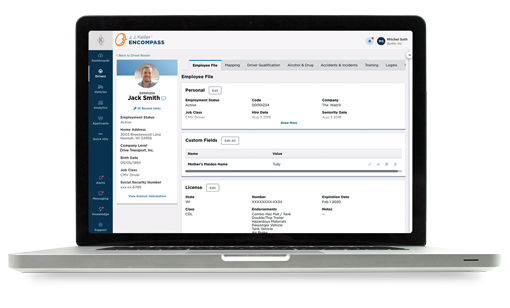Sr. Transportation Management Editor — J. J. Keller & Associates, Inc.
Embracing the Values of Safety Through Policies and Procedures
Clear policies and procedures are a critical piece of your organization's safety program. Here are some things to consider when developing yours.
Published On: 09/01/2024
This article was originally published in 2021, and updated in 2024.


Written by:
Mark Schedler
Organizations demonstrate safety as a core organizational value and priority through clear policies and procedures that define both acceptable, safe behaviors and unacceptable, unsafe behaviors. This includes associated consequences.
Once you develop (or update) and communicate your policies and procedures, drivers and office employees will understand performance boundaries and know better how to drive improvement. Inconsistencies in following procedures are harmful to a carrier’s case should litigation arise.
7 Focal Points for Safety Policies & Procedures
While the specifics are up to you, focus on developing comprehensive safety policies and procedures that do the following:
- Prioritize risky behavior events and trends for timely coaching.
- Provide a balanced measure of good and bad behaviors to gauge overall driver performance and risk.
- Define when and how (hands-on, class, online, etc.) to train and retrain people on specific skills.
- Outline when and how to discipline and terminate drivers and office employees when necessary, so it is clear to repeat offenders that they must stop the risky behavior or find another job.
- Maintain complete and compliant driver qualification records, including pre-employment history, MVRs, drug test results, and other required documentation.
- Outline when and how drivers will be recognized and rewarded for positive behaviors.
- Establish a document and data retention policy that is approved by your legal counsel and human resources department and is consistent with the progressive discipline policy.
Specific Elements of a Telematics Policy
Here are some elements you should consider when creating policies that deal with fleet telematics devices, such as dash cams and ELDs:
- Users must be thoroughly trained to run the system and understand event triggers.
- Dash cam video clips will be used for individual driver training and to prevent losses in defense of legal claims due to driver involvement in an accident.
- The camera cannot be remotely viewed in real-time unless there is an emergency.
- The system — ELD or dash cams — will not be used to spy on drivers.
- Recordings are safeguarded from unauthorized use and access.
- No images will be stored unless an event trigger has occurred, up to a specified number of seconds before and after the trigger.
- Employee consent is needed for any use of videos or data for training or other purposes. (However, consent may be a condition of employment.)
- Have a clear stance on owner-operator use of and any charges for the video-event system. Consult an attorney to minimize potential leasing regulation charge-back violations and misclassification issues. Misclassification can occur when an independent contractor is considered an employee for pay or worker’s compensation purposes.
- Require driver consent before collecting, storing, or using video clips or biometric data (fingerprint, retinal scan, voice signature).
- Performance coaching, document retention, and progressive discipline actions must be consistent with existing company policies and procedures.
Policy Reviews
Make sure your written safety policies never become out of date or ineffectual. Policies and procedures are living documents and should reflect state and federal regulation changes, as well as correspond to your organization as it grows and moves forward. Periodically review, evaluate, and revise the policies and procedures. Consider these best practices:
- Date each page of your written policies or policy manual to reflect its original date or last revision date.
- Maintain a record of all changes to provide a history for future reference.
- Keep a file for all company memos, directives, articles, and other items or sources that have initiated a change in your policies for future reference.
- Notify employees of changes. Timely notification is essential. Also, develop a mechanism for employee acknowledgment, such as an employee policy change sign-off form.
- Establish a regular schedule for reviewing your policies to make policy reviews a routine part of your role. Send a memo out to managers prior to your reviews asking for input and updates.
In Conclusion
After your policies and procedures are developed or updated, you should be able to answer “yes” to the following two questions:
- “Have we provided consistent leadership, clear guidance, and the appropriate tools to improve our safety and compliance culture?”
- “Have we maximized our investment in electronic performance monitoring systems to ensure profitability?”
If you can say yes to these two questions, you’ve done an excellent job embracing safety as a core value of your organization through your policies and procedures.
Manage Your Safety Program With J. J. Keller® Encompass
If you’re wondering how you can track policy and procedures training and documentation, J. J. Keller® Encompass can help. Built-in and customizable features help you stay on top of updating your policies and allow you to track related driver and employee training and communications. Talk with a fleet compliance specialist today for a no-obligation demo.
For more information on policy and procedure creation, download the Policies and Procedures for In-Cab Technology whitepaper. It’s free!
Hear from Our Experts!
Watch this episode of the DOT & ELD Regulatory Minute for guidance from J. J. Keller regulatory experts. Subscribe to our YouTube channel for the latest compliance & safety insights!
You may also enjoy the following articles:
Sign up for our newsletter!
We'll help you stay on top of regulations, best practices, and fleet industry news. Sign up to receive a monthly email notification with links to our most recent blog articles, free resources, and event invites.
